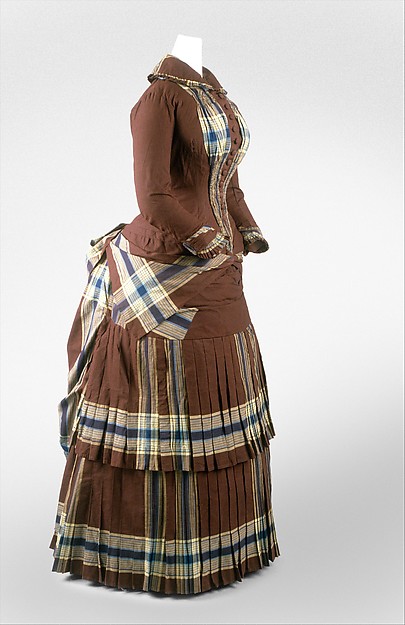
When women took up tricycling in the 1880s, the first question asked tended to be, “What should I wear?” Both men’s and women’s clothing during the 19th century was much more structured than most of the clothing we wear today. But at least men were able to wear pants. Women had to find a way to dress that looked appropriate (i.e. modest and fashionable), but was not hazardous.

Women who could afford to own tricycles were women of means, so they were able to afford specialized clothing for cycling. For women who had different dresses for walking, taking tea, and dinner, it would have made sense to have a different dress for tricycling as well. Granted, specialized cycling clothing in the 1880s did not look terribly different from other types of women’s dress. Unfortunately, I have not found any existing tricycling dresses, although it is possible some exist but no one knows they were used for tricycling.
Starting in seventeenth century, wealthy British women dressed in tailored woolen riding habits for riding horses. Riding habits were designed for women to ride side-saddle, and were designed with asymmetrical skirts that looked better on the horse than off the horse. Women were expected to change clothes before and after riding.
Fashionable women’s dress in the 1880s was cumbersome and in no way designed for athletic endeavors. Earlier in the decade, women’s dresses typically had a long, tight bodice with the volume gathered at the back of the skirt in a low bustle. Later on, the bustle, which is a device that thrusts the back of the skirt out, increased in volume. Women did not necessarily wear bustles with all of their clothing, and very large bustles were worn only for formal affairs.Tricycling costumes appear to have had either no bustle or a very small bustle that did not interfere with a seat or saddle.
For tricycling, women tended to wear tailored wool garments that shared some similarities with riding habits. While we we would probably look at tailored garments and find them quite “feminine,” they adapted traits from men’s garments. Their silhouettes tended to be simplified and they made it possible, if not exactly comfortable, for women to be more active.
Women’s clothing choices were considered to be very important to convince the public that it was acceptable for women to ride tricycles at all. Overall, neutral colors were recommended for tricycling costumes, as they were less likely to show dirt. Even more importantly, neutral colors drew less attention to a woman on a tricycle, or at least made her look more serious.

Writers recommended a range of styles women could choose from, but in general women wore a wool jacket with a matching wool skirt, which could be pleated (a common feature in fashionable every dress) or plain (more like a riding habit). Skirts, of course, were problematic because skirts that were too wide or long could get caught in the machine. Skirts that were too narrow or short were also a problem because they could show too much of a rider’s legs. Even the motion of a woman’s knees showing through her skirts was frowned upon.
One of the most discussed issues of women’s tricycling dress related to undergarments, which could not even be seen. Starting in the 1870s, women had begun wearing narrow trousers under riding habits. These trousers could not be seen underneath skirts and allowed women to ride without petticoats.
Some writers thought that women should also adopt knickerbockers (narrow knee-length trousers) or ordinary trousers for tricycling. Trousers were in danger of showing, but knickerbockers would have been difficult to see unless they showed through the skirt.
Others, however, were vehemently opposed to women wearing any form of pants under their skirts, arguing that it was masculine. Additionally, they meant that women would have to change clothes before and after riding if one were riding to a destination where appearance mattered. Perhaps the biggest issue was that advocates of tricycling were afraid that women would be less likely to cycle if they had to put on pants to do so.
Tricycling was a sport practiced by wealthy women who mostly likely were well-known in upper-class social circles. As cycling was still a questionable activity for women, they needed to convince others that one could ride a tricycle– even for long distances– and still be feminine. So writing about what to wear became a central way that early advocates tried to draw other women in (and convince their fathers or husbands that they should be allowed to cycle). Tricycling dress was used to demonstrate that cycling had become a socially acceptable sport for women.





Reblogged this on By the Mighty Mumford and commented:
DID YOU-ALL KNOW THIS INTERESTING STUFF???
LikeLike
I’m reminded of Miss F. J. Erskine in Lady Cycling: What to Wear & How to Ride when she wrote, “Wool above, wool below, wool all over, such is the Medes and Persians hygienic rule for cycling”
LikeLiked by 1 person
Oh yes, she is one of the sources I use in my dissertation. I’m not as specific here because of a lack of space, but I definitely know that quote.
LikeLike